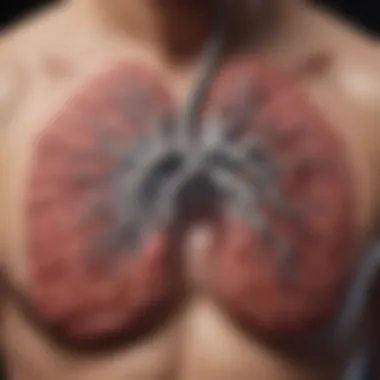COPD and Oxygen Saturation: Patient Care Insights


Intro
Chronic Obstructive Pulmonary Disease (COPD) represents a significant public health concern. It encompasses a group of lung disorders that cause breathing-related issues. Patients with COPD frequently experience reduced quality of life due to compromised respiratory function. Oxygen saturation (O2 saturation) levels serve as critical indicators of respiratory health, particularly in COPD patients. Understanding how these levels are influenced by the disease can materially enhance patient care and overall outcomes.
This article intends to illuminate the intricate relationship between COPD and oxygen saturation, examining their shared dynamics and the implications of this connection for healthcare providers. From monitoring O2 saturation to implementing effective management strategies, we will explore various dimensions of patient care tailored for those affected by COPD.
Through a comprehensive review of existing research and clinical best practices, the discussion aims to formulate a unified approach for optimizing care and improving life for individuals managing COPD.
Prologue to COPD
The exploration of Chronic Obstructive Pulmonary Disease (COPD) is essential in healthcare discussions. This condition is growing in prevalence, influencing the lives of millions worldwide. Understanding COPD allows healthcare professionals to implement precise management strategies. Effective patient care depends on recognizing how the disease impacts respiratory function and overall well-being.
COPD encompasses a range of respiratory problems, notably chronic bronchitis and emphysema. It is crucial to address both the medical and psychological implications of this condition. Effective management strategies hinge on understanding the complexities of COPD and its effects on oxygen saturation levels. Monitoring these levels can significantly enhance patient outcomes.
Definition of Chronic Obstructive Pulmonary Disease
Chronic Obstructive Pulmonary Disease is defined as a progressive lung disease that causes breathing difficulties. It is characterized by airflow obstruction, leading to less airflow during exhalation. COPD is often caused by long-term exposure to irritating gases or particulates, predominantly tobacco smoke. This disease is complex, influencing various systems in the body.
Epidemiology and Prevalence
The prevalence of COPD has increased globally, making it a significant public health issue. Data indicates that millions are affected, and it remains a leading cause of morbidity and mortality. Factors such as age, gender, smoking habits, and environmental exposures play a critical role in the epidemiology of this disease. Developing insights into the demographics of COPD patients helps tailor more effective interventions.
Pathophysiology of COPD
The pathophysiology of COPD involves a series of pathological changes within the lungs and airways. These changes include inflammation, mucus hypersecretion, and structural alterations. Over time, these factors contribute to devastating impacts on lung function. Inflammation in airways leads to narrowed passages, while emphysema results in the destruction of alveoli, significantly reducing gas exchange efficiency. Understanding this pathophysiological basis is important for developing treatment plans that address both symptoms and underlying causes.
"Recognizing the complexity of COPD can lead to better management outcomes and improved quality of life for patients."
Understanding the various aspects of COPD is critical for healthcare professionals. Well-informed strategies improve both individual care and public health approaches.
Understanding Oxygen Saturation
Understanding oxygen saturation is crucial when managing patients with Chronic Obstructive Pulmonary Disease (COPD). This concept not only encompasses the level of oxygen in a person's blood, but also reflects how well the respiratory system is functioning. Maintaining appropriate oxygen saturation is vital for overall health, particularly for individuals with respiratory conditions. A drop in oxygen saturation can lead to serious health complications, necessitating timely intervention and treatment.
What is O2 Saturation?
Oxygen saturation is the measure of how much oxygen the blood is carrying as a percentage of the maximum it could carry. It is typically measured using a pulse oximeter, a non-invasive device that attaches to a fingertip or ear lobe. Normal arterial oxygen saturation levels range from 95% to 100%. Values below this range indicate a reduced capacity of the blood to transport oxygen, which can impair organ function and lead to various symptoms, including fatigue, confusion, and shortness of breath. For those living with COPD, understanding O2 saturation can signal worsening respiratory status and inform necessary adjustments in care.
Normal vs. Low O2 Saturation Levels
When evaluating oxygen saturation, it is important to distinguish between normal and low levels. Low oxygen saturation, generally defined as a level below 90%, can indicate hypoxemia, a condition that may require immediate medical attention. The effects of low O2 saturation can vary:
- Mild Hypoxemia (90-94%): Often asymptomatic but may lead to increased heart rate or slight confusion.
- Moderate Hypoxemia (85-89%): More severe symptoms can occur, including increased shortness of breath, altered mental state, or fatigue.
- Severe Hypoxemia (below 85%): This level is very dangerous and can result in serious complications such as organ dysfunction or failure.
Monitoring these levels allows healthcare providers to tailor interventions effectively and ensure patient safety.
Methods of Measuring O2 Saturation
There are several methods used to measure oxygen saturation, each with its own advantages and limitations:
- Pulse Oximetry: This is the most common method. It provides quick, non-invasive readings and is widely used in both clinical and home settings.
- Arterial Blood Gas (ABG) Analysis: This more invasive procedure involves drawing blood directly from an artery. It gives precise oxygen saturation values along with other important respiratory data.
- Capnography: While primarily used to measure carbon dioxide levels, capnography can support the assessment of oxygen status when used alongside other methods.
Understanding these measurement techniques is essential for assessing patient needs and determining steps for effective management. Regular monitoring of oxygen saturation makes it possible to detect early signs of deterioration and implement appropriate intervention strategies.
The Connection Between COPD and O2 Saturation
The connection between Chronic Obstructive Pulmonary Disease (COPD) and oxygen saturation is crucial to understand in the realm of respiratory health. COPD is a progressive condition that adversely affects lung function. This deterioration leads to difficulties in gas exchange, essential for maintaining adequate oxygen levels in the body.


O2 saturation reflects the amount of oxygen carried by hemoglobin in the bloodstream. Monitoring oxygen saturation levels in COPD patients becomes necessary to evaluate respiratory function and adjust treatment accordingly. This link can inform healthcare providers about patient status, risks, and potential interventions.
Impact of COPD on Oxygen Exchange
COPD changes the structure and function of the lungs. Unlike healthy lungs, the air sacs become damaged and less efficient in gas exchange processes. This inefficiency leads to lower oxygen levels available in the bloodstream.
When COPD patients breathe, the inflow of air is typically restricted, making it harder for them to exhale fully. This process results in residual air within the lungs, preventing fresh oxygen from entering effectively. Over time, less oxygen in the blood can lead to fatigue and other systemic issues, impairing overall well-being.
Consequences of Impaired O2 Saturation
Impaired O2 saturation can trigger a series of serious consequences for individuals with COPD. Just a few examples include:
- Reduced exercise tolerance. Patients may struggle with physical activity, leading to a sedentary lifestyle.
- Increased respiratory distress. As oxygen levels fall, the risk of exacerbating COPD symptoms rises.
- Compromised heart function. The heart works harder to pump blood with lower oxygen content, increasing stress on the cardiovascular system.
In extreme cases, chronic low O2 levels may result in cor pulmonale, a condition where the right side of the heart enlarges due to increased pressure in the pulmonary arteries.
Hypoxia in COPD Patients
Hypoxia, or low oxygen levels in the body, is a common occurrence in COPD patients. This condition can present both acutely and chronically.
Acute hypoxia can arise during COPD exacerbations, where symptoms worsen suddenly due to infections or environmental triggers. Alternatively, chronic hypoxia develops gradually over time as lung function declines. Chronic hypoxia could also lead to complications, including cognitive impairment and other organ dysfunctions.
Monitoring oxygen saturation in COPD patients provides insight into the effectiveness of treatment interventions. It can also help identify when supplemental oxygen might be necessary, aiding in better disease management.
"Regular monitoring of oxygen saturation can significantly improve both patient outcomes and quality of life for individuals with COPD."
Through this understanding, healthcare professionals can offer tailored approaches to patient care, ensuring optimal management of COPD and associated conditions.
Clinical Significance of O2 Saturation Monitoring
Oxygen saturation monitoring plays a critical role in the management of Chronic Obstructive Pulmonary Disease (COPD). The significance of consistently tracking these levels lies in its capacity to uncover insights related to the patient's respiratory status. Early detection of hypoxemia, for example, can lead to timely interventions that may prevent severe complications. In COPD patients, who often struggle with reduced pulmonary function, monitoring oxygen saturation becomes not just beneficial but essential.
Maintaining adequate O2 saturation levels helps to ensure that all body tissues receive enough oxygen. When levels drop below optimal thresholds, it can lead to detrimental effects on organ function. Healthcare providers can use this information to tailor management strategies effectively.
Why Monitor O2 Saturation in COPD?
Tracking O2 saturation in COPD patients aids in identifying how effectively the lungs are delivering oxygen to the bloodstream. Given the nature of COPD, where airflow is often compromised due to inflammation and obstruction of the airways, keeping a close eye on oxygen levels is vital.
By constantly monitoring O2 saturation, clinicians can ascertain several key aspects:
- Detection of Respiratory Distress: A sudden drop in oxygen levels might indicate worsening respiratory function, prompting immediate assessment.
- Guidance for Oxygen Therapy: It helps decide when patients need supplemental oxygen, as well as how much they may require.
- Assessment of Treatment Efficacy: Regular checks allow healthcare providers to evaluate the effectiveness of currently employed treatments.
Interpreting O2 Saturation Results
Understanding oxygen saturation results is crucial for appropriate patient care. The standard reference range for O2 saturation levels is typically between 95% and 100%. Levels consistently below 90% could be indicative of significant issues, necessitating urgent clinical attention.
When interpreting these results, consider the following:
- Baseline Variations: Each patient may have a different baseline, especially if they have a long history of COPD. Previous records can provide context to current readings.
- Underlying Conditions: Other medical conditions may affect O2 saturation, complicating interpretations.
- Activity Level: Saturation can fluctuate depending on whether the patient is resting or engaging in physical activity.
Adjusting Treatment Based on O2 Levels
Once O2 saturation results are obtained, clinicians can adjust treatment strategies as necessary. Here are a few considerations for tailoring care:
- Oxygen Therapy Adjustments: If a patient’s O2 levels are persistently low, increasing the flow rate on supplemental oxygen may be required.
- Medication Review: Certain medications may need to be altered or intensified; bronchodilators and corticosteroids are common examples that can assist in enhancing airflow.
- Lifestyle Modifications: Beyond immediate medical adjustments, recommendations often include lifestyle changes, such as incorporating pulmonary rehabilitation or quitting smoking to help improve overall lung capacity and function.
"Monitoring O2 saturation provides essential information that directly influences clinical decisions, improving outcomes for patients with COPD."


O2 Therapy in COPD Management
Oxygen therapy is a cornerstone in managing Chronic Obstructive Pulmonary Disease (COPD). It is vital for improving patients' quality of life and enhancing overall health status. COPD leads to impaired oxygen exchange, resulting in low oxygen saturation levels. Delivering supplemental oxygen can help normalize these levels. This therapy not only alleviates symptoms but also helps to prevent further complications. In this section, we will discuss the different types of oxygen therapy, the indications for their use, and potential risks and considerations.
Types of Oxygen Therapy
There are several types of oxygen therapy available for COPD management. Each type serves a specific purpose based on the patient's needs. Some common forms include:
- Continuous flow oxygen therapy: This is a traditional method where oxygen flows steadily to the patient. It is typically used at home or in clinical settings.
- Pulse dose oxygen therapy: This is a more advanced form. It delivers oxygen on demand when the patient inhales, making it more efficient and portable.
- High-flow nasal cannula: This is a newer method offering higher oxygen concentrations. It can improve oxygenation and is often used in acute settings.
- Non-invasive ventilation: Though not exclusively oxygen therapy, this method uses pressure to help keep airways open. It is essential for severe COPD cases.
Each type has unique applications, and caregivers must assess which method best fits a patient's condition.
Indications for Oxygen Therapy
Oxygen therapy is indicated for those with specific clinical needs. The primary indications include:
- Hypoxemia: Low blood oxygen levels can lead to severe health issues. Oxygen therapy is essential for patients experiencing significant hypoxemia.
- COPD exacerbations: During flare-ups, patients may require additional oxygen to manage symptoms effectively.
- Preoperative and postoperative care: Ensuring adequate oxygen levels is crucial for patients undergoing surgical procedures, particularly those with COPD.
- End-of-life care: Patients in advanced stages of COPD may need oxygen for comfort and symptom relief.
These criteria help healthcare providers determine when to initiate oxygen therapy, ensuring it aligns with clinical needs.
Potential Risks and Considerations
While oxygen therapy provides substantial benefits, potential risks exist that healthcare professionals must consider. These include:
- Oxygen toxicity: Prolonged exposure to high levels of oxygen can lead to lung damage. Care must be taken to avoid over-oxygenation, especially if the patient has coexisting health issues.
- Carbon dioxide retention: Some COPD patients retain carbon dioxide (CO2). Increasing oxygen flow can lead to further CO2 buildup, resulting in respiratory acidosis.
- Fire hazards: Oxygen supports combustion. Therefore, it is essential to educate patients and families about fire risks associated with oxygen use.
- Psychological dependence: Some patients may become reliant on oxygen therapy, leading to anxiety about being off oxygen.
It is crucial for healthcare professionals to monitor patients closely and educate them about these risks. Comprehensive assessments and tailored approaches to oxygen therapy can minimize potential complications.
Optimal management of oxygen therapy in COPD patients contributes to better health outcomes and can significantly improve life quality.
In summary, oxygen therapy plays a critical role in COPD management. Understanding its types, indications, and potential risks helps healthcare professionals provide effective care tailored to individual patients.
Emerging Research and Innovations
Emerging research and innovations play a crucial role in understanding and managing Chronic Obstructive Pulmonary Disease (COPD) and its implications for oxygen saturation monitoring. As we journey deeper into this terrain, it becomes clear that advancements offer fresh insights that could enhance patient care. The dynamic nature of medical research opens doors to novel interventions and technologies that hold the potential to significantly improve outcomes for COPD patients.
Recent Advances in COPD Research
Recent studies have broadened our understanding of the underlying mechanisms of COPD. Research now emphasizes the genetic component in disease progression. For instance, discoveries in biomarkers could lead to personalized therapies, tailoring treatments to individual patient profiles. Notably, studies published in reputable journals have explored the role of inflammation in COPD, shedding light on new drug targets that could mitigate the disease's impact on lung function. Moreover, trial results suggest that newer anti-inflammatory agents may help manage symptoms more effectively.
Innovative approaches, including telemedicine and remote monitoring, have also gained traction. These methods allow for continuous assessment of patients' conditions, leading to timely interventions. The incorporation of mobile health applications is reshaping routine care. Patients can track their symptoms and oxygen levels in real time, contributing to better self-management and communication with healthcare providers.
Future Directions in O2 Saturation Monitoring
The future of oxygen saturation monitoring looks promising, driven by technological advancements. Non-invasive monitoring techniques are evolving, making it easier for patients to assess their oxygen levels without discomfort. Devices such as wearable pulse oximeters are becoming more sophisticated, offering continuous monitoring and data analytics capabilities. These innovations facilitate easier data collection, allowing for a comprehensive understanding of trends over time.
The integration of artificial intelligence (AI) in monitoring systems holds the potential to enhance predictive analytics. AI algorithms can analyze vast amounts of data to detect patterns that might escape traditional monitoring. This could lead to early identification of COPD exacerbations, enabling proactive interventions. Furthermore, automated alerts to patients and healthcare teams based on their O2 saturation trends could revolutionize management strategies, enhancing timely and appropriate care adjustments.
Integrating Technology in COPD Care
As technology continues to advance, its integration into routine COPD care is becoming indispensable. Digital platforms offer resources for education and support, crucial for empowering patients in their management journey. Online communities and forums facilitate peer interaction, providing emotional support and sharing practical tips on dealing with COPD.
In clinical settings, the use of electronic health records (EHRs) can streamline information sharing among healthcare providers. This ensures that all team members have access to up-to-date patient data, facilitating coordinated care. Moreover, the introduction of telehealth services provides COPD patients with greater accessibility to specialists, reducing travel burdens and allowing timely consultations.
Stakeholders in healthcare must adopt these technological innovations thoughtfully, considering both the benefits and challenges they present. Training for healthcare professionals and patients alike is essential to maximize the potential of these tools. Integrating technology thoughtfully will likely yield better health outcomes for individuals managing COPD, ultimately enriching their quality of life.
"The evolution of technology is crucial in redefining care models for COPD, enhancing the ability to monitor and manage this chronic condition effectively."


Epilogue
The conclusion serves as a critical reminder of the core themes presented throughout this article. Understanding the interplay between Chronic Obstructive Pulmonary Disease (COPD) and oxygen saturation is not merely academic. It directly affects patient care and health outcomes. By distilling complex concepts into actionable insights, healthcare professionals are better equipped to make informed decisions.
Summary of Key Points
- Definition and Significance of COPD: Chronic Obstructive Pulmonary Disease is a progressive respiratory condition characterized by airflow limitation. The awareness of COPD prevalence highlights the burden it places on healthcare systems worldwide.
- Understanding O2 Saturation: Oxygen saturation is a critical indicator of respiratory efficiency. Normal levels are vital for organ function and overall health. Continuous monitoring can provide early warnings of deterioration in lung function.
- Impact on Patient Care: Patients with COPD often experience fluctuating oxygen levels. Addressing these changes through observation and proper management can greatly enhance quality of life.
- Oxygen Therapy: Appropriate use of oxygen therapy can alleviate symptoms and prevent complications, but it requires careful consideration of individual patient needs.
- Emerging Research: Advances in monitoring techniques and treatment methods continue to evolve, giving hope for improved management of COPD and related impairments.
Implications for Patient Care
The implications for patient care are profound. Ensuring that healthcare practitioners have a thorough understanding of COPD and its associated oxygen saturation levels creates an opportunity for tailored management strategies. Each patient's experience is unique, necessitating an individualized approach that considers their particular health status, lifestyle, and preferences.
"An informed strategy leads to better outcomes for patients with COPD, emphasizing the crucial link between monitoring O2 levels and effective treatment."
Improving outcomes involves recognizing the need for ongoing education and training among healthcare professionals. By fostering an environment where patients are empowered to understand their condition and actively participate in their care, significant positive changes can be observed.
In sum, the integration of insights regarding COPD and oxygen saturation into daily clinical practice can enhance the quality of care provided to patients, ultimately resulting in a more favorable prognosis.
Key Studies and Articles
Several studies stand out in the exploration of COPD and oxygen saturation. The Global Initiative for Chronic Obstructive Lung Disease (GOLD) report is a widely recognized standard that offers guidelines on the management of COPD. It highlights essential findings regarding the prevalence of oxygen desaturation among COPD patients and its direct correlation to health outcomes.
Recent research published in journals like "Chest" and the "American Journal of Respiratory and Critical Care Medicine" has focused on innovative approaches to oxygen therapy. These studies emphasize monitoring strategies and their role in improving patient care.
The importance of accurate O2 saturation measurements cannot be understated; they directly influence treatment protocols and patient outcomes.
In addition to peer-reviewed articles, systematic reviews provide comprehensive insights into the efficacy of various management strategies, enhancing our understanding of existing treatment modalities.
Guidelines for Clinical Practice
Clinical practice guidelines, such as those from the American Thoracic Society, present recommendations that help standardize care for COPD patients. These guidelines are based on extensive reviews of literature and collective expert consensus.
Key considerations within these guidelines include the appropriate use of pulmonary function tests, understanding the stages of COPD, and the importance of regular monitoring of oxygen saturation levels. They also broadly cover the indications for initiating oxygen therapy and patient education, ensuring that caregivers understand the rationale behind specific treatments.
Incorporating these guidelines into everyday practice can lead to improved patient outcomes by fostering a structured approach to management. When healthcare professionals adhere to these protocols, they create an environment where informed decisions can be made, ultimately leading to optimized patient care.
For more detailed guidance, healthcare practitioners can refer to the latest GOLD guidelines and the American Thoracic Society recommendations to stay updated on best practices in managing COPD.
To access valuable resources, visit:
Understanding and applying these references and guidelines is critical for anyone involved in the care of COPD patients, ensuring that they remain informed and equipped to provide the best possible support.
Further Reading
Further reading is a valuable aspect when exploring complex medical topics, such as COPD and oxygen saturation levels. This section aims to guide readers towards resources that deepen their understanding and refine their knowledge about these subjects. Whether you are a student, researcher, or healthcare professional, accessing high-quality references is essential for staying informed about current treatments and practices in COPD management. These resources not only provide foundational knowledge but also insights into emerging research, innovative techniques, and best practices to optimize patient care.
Books on COPD Management
Books about COPD management encompass various topics, from physiological backgrounds to management strategies. They offer detailed insights that are crucial for both novice learners and experienced practitioners.
- "Chronic Obstructive Pulmonary Disease: A Global Perspective" by Peter J. Barnes and David P. Celli is a comprehensive resource covering the latest research developments in COPD and management techniques for clinicians.
- "Living with COPD: Your Complete Guide to Health and Wellness" by Mildred W. Williamson provides practical advice for patients and caregivers. This book emphasizes coping strategies and lifestyle modifications to enhance quality of life.
- "The COPD Handbook: A Guide to Health Care Providers and Patients" by Jennifer W. Hall offers practical guidelines for clinicians. It features protocols for assessment, treatment, and ongoing management of COPD in daily practice.
These books serve as essential references for those looking to improve their understanding and application of COPD management principles.
Online Resources and Communities
The internet is a rich source of information on COPD management. Online resources foster community engagement and discussion, allowing group learning and shared experiences. Here are some reputable sources:
- The American Lung Association (lung.org) offers extensive information on COPD, including educational resources and support tools for patients and caregivers.
- COPD Foundation (copdfoundation.org) provides a comprehensive overview of COPD, cloud-based management solutions, and patient education materials.
- Reddit communities such as r/COPD create a support system for those affected by the disease. Participating in discussions allows individuals to share their experiences and solutions effectively.
- Facebook groups dedicated to COPD can further enhance communication and provide peer support for individuals facing similar struggles.
By exploring these online resources, practitioners and patients can remain informed about the latest advancements and connect with others who can offer insightful perspectives on living with COPD.



